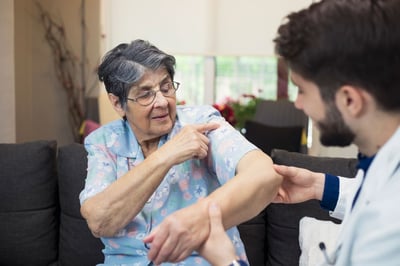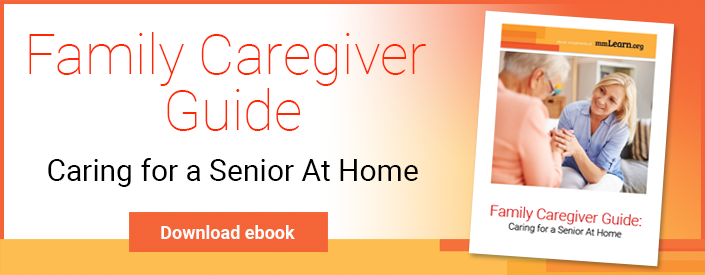 Pain is a public health crisis.
Pain is a public health crisis.
If you look at the numbers, it appears we are a nation in pain. In fact, chronic pain is one of the main reasons older Americans visit doctors. A 2018 study by the Centers for Disease Control (CDC) found that 52% of people 65 and older listed chronic conditions as their reason for visiting a doctor.
We are learning more every day about the dangers of opioid painkillers. Using them for too long or using them improperly can lead to dangerous addiction issues, so the medical community is always looking for ways to address pain in safer ways.
In this mmlearn video, Dr. Alexander Peralta Jr., a palliative medicine specialist, shares some research, wisdom, and research on pain management for the elderly.
What Is Pain?
Pain is a slippery concept. One definition Dr. Peralta shares is from the journal Pain: “An unpleasant sensory and emotional experience associated with action or potential tissue damage or described in terms of such damage.”
But Margo McCaffery, a nurse and pioneer in the pain management field, has a broader definition: “Pain is what the experiencing person says it is, existing whenever he or she says it does.”
3 Types of Pain
The three main types of pain are acute pain, which usually follows an injury and heals when the injury heals; cancer pain, which is usually related to tumor progression or treatment; and chronic pain.
Chronic pain is not just in the physical body. It exists in four dimensions:
- Physical
- Psychological
- Social
- Spiritual
Because of its all‑encompassing nature, pain shows up in many different areas of our lives.
People with chronic pain may also experience
- Fatigue
- Insomnia
- Weight gain
- Body aches
- Foggy-headedness
- Short‑term memory loss
- Anxiety, depression, hopelessness
- Cravings
Patients at Risk for Pain
Pain is a serious risk for people with the following diseases:
- Cancer
- Dementia
- Cardiovascular disease
- Pulmonary disease
- Neurological diseases like strokes, ALS, MS, MD, and mental impairment
- End‑stage organ disease
- AIDS
- Osteoarthritis, rheumatoid arthritis, vertebral compression
- Congenital anomalies such as sickle cell disease and spinal muscular atrophy
What are the current guidelines for pain management when it comes to the domain of physical pain?
Guidelines for Pain Management
When someone is suffering, the top goal of their medical team is to use the latest medical advancements to manage the pain with as few side effects as possible.
One person can’t cure pain, and it rarely works to just hand someone medication. The best approaches are interdisciplinary, meaning the patient and family caregiver will talk to a social worker, a chaplain, a pain specialist, a nurse, and other people involved in their care.
The team will conduct ongoing assessments of pain and other symptoms (like shortness of breath, weakness, fatigue, anorexia, depression).
The team is trying to understand the deeper causes of the pain. They also want to make sure that the patient and family understand the disease and its symptoms and the possible side effects of treatment.
The reason it takes a team is to address all the physical, psychological, social, and spiritual aspects of pain.
Defining Palliative Care
Palliative care is an approach to care that is both philosophical and medical. It is not the same as end‑of‑life care or hospice, but it does share some similarities in its holistic approach to pain and suffering. The National Census Project for Quality Palliative Care says, “the goal of palliative care is to prevent and relieve suffering and to support the best possible quality of life for patients and their families, regardless of the stage of the disease or the need for other therapies.”
Palliative care professionals consider the many dimensions or domains of care, including physical, psychological, social, spiritual, cultural, legal, and ethical.
Understanding Opioids and Recognizing Addiction
Opioid pain medications are often used to treat chronic pain. And they can be very effective. But patients and families need to understand what the different pain medications do and how to recognize signs of addiction.
Opioid addiction is a serious issue in the United States, and some of it begins when patients are seeking relief from pain.
To avoid patients' becoming addicted to these powerful substances, it’s important to learn and be aware of what is called the “addiction cycle”: preoccupation‑anticipation, binge‑intoxication, and withdrawal‑negative affect.
This cycle causes stress to the body and brain and even changes the way the brain is wired.
The patient becomes a different person. “It’s hard to come back and be normal,” says Dr. Peralta.
That doesn’t mean that all pain medications are harmful. The American Society for Addiction Medicine (ASAM) lists the following 4 Cs to help evaluate whether someone is abusing prescription medications.
- Loss of control over the use of medications
- Compulsive use of the medications
- Continued use despite harm
- Cravings for drugs
Exploring Neuroplasticity in Pain Management
In recent years, we have been learning a lot about the concept of neuroplasticity. This is the brain’s amazing ability to rewire itself, creating different pathways to compensate for injury.
Neuroplasticity might explain why some pain medications stop working for patients and why other people experience relief and don’t know why.
Non‑opioid Solutions
Here’s some more good news: Marijuana is not just for hippies. Dr. Peralta says, “Marijuana works” as a pain reliever. In another video, Dr. Peralta describes the effects of cannabinoids in relieving pain, increasing appetite in cancer patients, and helping to fight inflammation that accompanies chronic pain.
He discusses synthetic THC (marinol), which is often prescribed for chemotherapy and AIDS patients, and phytocannabinoids, substances derived from plants and available in states where medical marijuana is legal.
But THC does have some complications and side effects, including anxiety and panic attacks, psychosis, paranoia, and more. And it can take a lot of cannabis to manage pain.
Other promising non‑opioid methods exist for managing pain. These include
- Local anesthetics like bupivacaine and lidocaine
- Anti‑inflammatory drugs like diclofenac, flurbiprofen, and ketoprofen
- Non‑opiates that help with muscle spasms like cyclobenzaprine and baclofen
- Alfa‑2A adrenoreceptor agonists such as clonidine, which is used in transdermal patches or pain pumps
- Antidepressants
- Anticonvulsants like gabapentin, carbamazepine, and dilantin
- Ketamine
- Calcium channel blockers
Let’s Talk about Pain
There are many paths to pain relief and multiple ways to manage pain. And scientists are discovering more about this complex process every day. Like all types of caregiving issues, pain management in the elderly requires clear communication with health care providers and our loved ones. Talk to your loved one about whether they are experiencing pain in any of these dimensions: physical, psychological, social, or spiritual. Ask questions of providers until you feel satisfied that your loved one is getting the best care possible.

